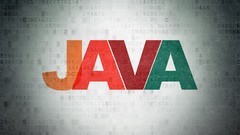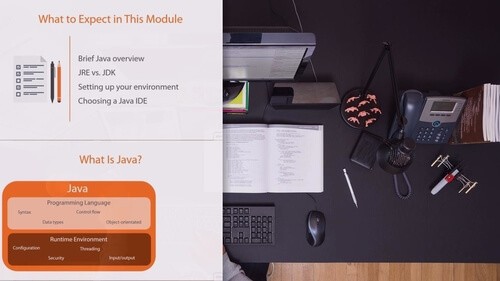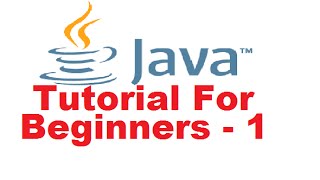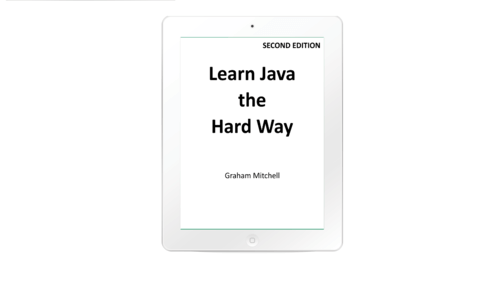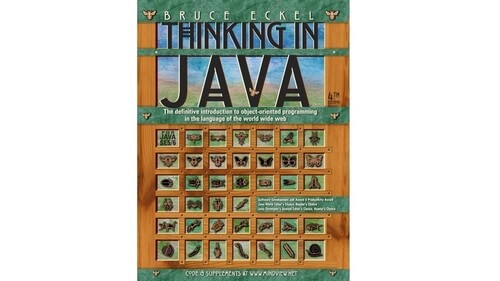25 Best + Free Java Courses & Certificates [2021]
- 1. The Complete Java Certification Course [Udemy] - Best Paid Course
- 2. Java Programming [University of Helsinki MOOC] - Best Free Course
- 3. Java Video Tutorial [YouTube] - Best YouTube Tutorial
- 4. Object Oriented Programming in Java [Coursera] - Best Advanced Course
- 5. Learn Java [Codecademy] - Best Practical Course
- 6. Effective Java [Addison-Wesley Professional] - Best Text Based Course
- 7. Java Fundamentals: The Java Language [PluralSight]
- 8. Java Tutorial For Beginners [YouTube]
- 9. Learn Java the Hard Way [Learn Java The Hard Way]
- 10. Java Programming Masterclass for Software Developers [Udemy]
As featured on Harvard EDU, Stackify and Inc - CourseDuck identifies and rates the Best Java Courses, Tutorials, Providers and Certifications, based on 12,000+ student reviews, public mentions, recommendations, ratings and polling 5,000+ highly active StackOverFlow members. Learn more
💻 Which Java Course Provider is best for me?
- Udemy and Eduonix are best for practical, low cost and high quality Java courses.
- Coursera, Udacity and EdX are the best providers for a Java certificate, as many come from top Ivy League Universities.
- YouTube is best for free Java crash courses.
- PluralSight, SkillShare and LinkedIn are the best monthly subscription platforms if you want to take multiple Java courses.
- Independent Providers for Java courses & certificates are generally hit or miss.
💼 What is Java used for?
Developing an OOP application is much easier, and it also helps to keep system modular, flexible, and extensible. Once you have knowledge of crucial OOP concepts like Abstraction, Encapsulation, Polymorphism, and Inheritance, you can use all those with Java.
📃 Is a Java Certificate worth it?
Yes and No. Certified Java developers on average make more money. Having a Java certificate greatly increases the chance of landing an interview and can open otherwise closed doors. Coursera, Udacity and EdX offer excellent certificate options for impressing your future employers. Eduonix, Udemy and several other providers offer certificates, but they aren't as reputable. If you have a Computer Science Degree, certificates are not as important. Still, many employers won't care about certificates, but rather your interview skills, experience and/or skills assessment.
Sort By:
Provider
University
Tags
Rating
Duration
Difficulty
Publication Year
Language
226 Filtered Courses
Best Paid Course
1 )
The Complete Java Certification Course (2022)
4.4
Become a confident industry ready core Java developer and get certified as a Java professional!
 What You'll Learn
What You'll Learn
- How to write Java programs from scratch and have loads of fun in the process
- Go from zero to hero in writing industry ready Java programs
- Gain enough experience to pass a core Java programming interview and perform well on the job
- Be prepared to take the Java certification exam for OCAJP 1Z0-808
Best Free Course
2 )
Java Programming (2013)
4.8
This six-week online course was developed by the University of Helsinki. It mirrors the university class that covers the basics of computer programming, algorithms and object-oriented programming with Java. A follow-up six-week course is available upon completion of this introductory course.

Pros

Cons
-
- Course is run by a university and includes certificates of achievement.
- Beginner-friendly approach to Java and object-oriented programming. Absolutely no coding background is necessary.
- Clear, manageable pace for first-time coders.
- Additional six-week course is available upon completion for a deeper understanding of the covered concepts.
-
- Program was originally crafted in Finnish and does offer minor language barriers in English.
- Does not include community support expected with traditional massively online courses.
- Much more time intensive than comparable courses.
- Does not get beyond the most basic application of introductory concepts.
Best YouTube Tutorial
3 )
Java Video Tutorial (2011)
4.5
Created by Derek Banas, this 60-part video series covers Java from basics to advanced applications. The videos average between 10 and 15 minutes, and the entire course will run more than 10 hours of playtime. It remains one of the most comprehensive introductions to Java on YouTube.

Pros

Cons
-
- The YouTube series is completely free to use.
- Video delivery makes lessons clear and easy to follow.
- Lessons are fast-paced and unlikely to leave you bored or frustrated.
- Course goes well beyond the introductory basics of most comparable instruction.
- Final lesson series covers the complete process of building a video game application from scratch.
-
- While it starts with introductory concepts, it is not specifically designed for first-time coders.
- As it is entirely pre-recorded, there is no direct, interactive learning with the instructor.
- Explored concepts are mostly generalized. Specific application is lacking.
- The fast pace of lessons can be intimidating for some who are new to programming.
Best Advanced Course
4 )
Object Oriented Programming in Java (2015)
5.0
Designed by Coursera, this introduction to Java and object-oriented programming (OOP) is designed for students of all backgrounds. The general introduction is the first in a multi-course series that goes from introduction into advanced Java concepts. It is designed to teach Java concepts as well as fulfill continued-learning requirements for certifications and job requirements.

Pros

Cons
-
- Part of a holistic program that trains students to become Java specialists.
- Peer-based reviewing exposes students to a wider range of approaches and processes than many comparable courses.
- Quizzes help students focus on core concepts and retain information.
- Course toes the line between theoretical and practical knowledge, better preparing students for more advanced instruction to come.
-
- Course does not sufficiently use project-based testing to help students apply course knowledge.
- Even though the course is introductory, it requires a programming background as a prerequisite.
- Peer reviews provide an unequal experience as not all students will put the same effort into the review process.
Best Practical Course
5 )
Learn Java (2016)
3.4
Created by Codecademy, this 25-hour class covers a full introduction to Java and object-oriented programming. It covers seven different coding projects to take you from the absolute beginning into basic proficiency. You can explore the free version or upgrade to the pro version to attain additional resources.

Pros

Cons
-
- The free version covers all of the material.
- No specialized software is needed for IDE. The entire program is in-browser.
- Massive student community provides help and support at any and every point in the program.
- Codecademy offers similar courses in every major coding language.
-
- Lesson paces can feel slow as the program only covers introductory material.
- Free version does not supply specific help if you get stuck.
- Not designed for people with coding experience.
- Course is insufficient to develop complete proficiency with Java.
- Additional learning will be necessary.
Best Text Based Course
6 )
Effective Java (2018)
4.6
Java has changed dramatically since the previous edition of Effective Java was published shortly after the release of Java 6. This Jolt award-winning classic has now been thoroughly updated to take full advantage of the latest language and library features. The support in modern Java for multiple paradigms increases the need for specific best-practices advice, and this book delivers. As in previous editions, each chapter of Effective Java, Third Edition, consists of several "items," each presented in the form of a short, stand-alone essay that provides specific advice, insight into Java platform subtleties, and updated code examples. The comprehensive descriptions and explanations for each item illuminate what to do, what not to do, and why. The third edition covers language and library features added in Java 7, 8, and 9, including the functional programming constructs that were added to its object-oriented roots. Many new items have been added, including a chapter devoted to lambdas and streams. New coverage includesFunctional interfaces, lambda expressions, method references, and streamsDefault and static methods in interfacesType inference, including the diamond operator for generic typesThe @SafeVarargs annotationThe try-with-resources statementNew library features such as the Optional interface, java.time, and the convenience factory methods for collections
 Quality Score
Quality Score
Content Quality
/
Video Quality
/
Qualified Instructor
/
Course Pace
/
Course Depth & Coverage
/
Overall Score : 94 / 100
7 )
Java Fundamentals: The Java Language (2015)
4.5
Pluralsight offers this eight-hour course to beginners in Java coding. It goes over the foundational concepts needed to develop Java apps, including Android, server-side and client-based development. No prior experience with Java or programming is necessary to complete this course.

Pros

Cons
-
- The free trial allows you to get a feel for the class before you commit to the time and money to completing it.
- The course covers a comprehensive set of topics for Java beginners.
- Practical learning ensures that the course cannot be completed without a working knowledge of each topic that is covered.
-
- With just under eight hours of instruction, the course offers less overall instruction for each concept than many peer courses.
- Course requires a Pluralsight membership. You cannot simply pay for the single course and keep it.
- This course does not go beyond beginner levels in each topic.
8 )
Java Tutorial For Beginners (2014)
4.2
This YouTube tutorial, hosted by ProgrammingKnowledge, has helped more than a million aspiring programmers learn the fundamentals of Java. The course runs over roughly 13 hours of video instruction, with many more hours of supplemental material. The video series covers Java and JavaFX, providing far more overall knowledge than most introductory Java courses.

Pros

Cons
-
- Being on YouTube, the entire course is free and can be repeated as often as you like.
- Course is broken into 77 concise, easy-to-consume video modules with 30 additional supplemental videos.
- Supplemental content includes detailed tutorials for installing and using learning resources, such as a Java Runtime Environment.
-
- There is no direct interaction with the instructor. Everything is in pre-recorded videos only.
- The entire course is long, although many prior students recommend increasing the playback speed to save time.
- While the knowledge is valuable, this is not part of a certification program.
9 )
Learn Java the Hard Way (2013)
4.6
"Learn Java the Hard Way" is a book with tutorial videos that teaches you how to code the same way a lot of us learned as children in the 1980s: typing in short, simple programs and getting them to work.The exercises and explanations in this book are distilled from my nearly two decades of experience teaching programming to ordinary students. Over 2,000 students have taken my classes and nine months later almost all of them knew how to code - at least a little!If you have ever bought another Java book for "beginners" and been lost by page 10, then my book is for you.
 Quality Score
Quality Score
Content Quality
/
Video Quality
/
Qualified Instructor
/
Course Pace
/
Course Depth & Coverage
/
Overall Score : 94 / 100
10 )
Java Programming Masterclass for Software Developers (2022)
4.2
This Java master class was designed for people who want to work as a Java developer or acquire the Oracle Java Certification. The 400 lectures cover more than 80 hours of learning. Completing this course will prepare you for Spring Framework, Android development and many more applications.

Pros

Cons
-
- Course was created by Tim Buchalka, a household name in Java instruction.
- Course is designed around real-world problem solving, with a challenge for every lesson.
- Course is available in multiple translations and has touted success globally.
- Lessons start at an introductory level. This class is accessible for all levels and still takes students deep into Java development.
-
- Content is delivered via high-definition videos. They can eat a lot of data and are prone to lagging, depending on connection speeds.
- 80 hours of instruction makes this course substantially longer than many of its peers.
- The exercises can be challenging and frustrating to complete.
11 )
Thinking in Java (2006)
0.0
"Thinking in Java should be read cover to cover by every Java programmer, then kept close at hand for frequent reference. The exercises are challenging, and the chapter on Collections is superb! Not only did this book help me to pass the Sun Certified Java Programmer exam; it's also the first book I turn to whenever I have a Java question."- Jim Pleger, Loudoun County (Virginia) Government"Much better than any other Java book I've seen. Make that 'by an order of magnitude'.... Very complete, with excellent right-to-the-point examples and intelligent, not dumbed-down, explanations.... In contrast to many other Java books I found it to be unusually mature, consistent, intellectually honest, well-written, and precise. IMHO, an ideal book for studying Java."- Anatoly Vorobey, Technion University, Haifa, Israel"Absolutely one of the best programming tutorials I've seen for any language."- Joakim Ziegler, FIX sysop"Thank you again for your awesome book. I was really floundering (being a non-C programmer), but your book has brought me up to speed as fast as I could read it. It's really cool to be able to understand the underlying principles and concepts from the start, rather than having to try to build that conceptual model through trial and error. Hopefully I will be able to attend your seminar in the not-too-distant future."- Randall R. Hawley, automation technician, Eli Lilly & Co."This is one of the best books I've read about a programming language.... The best book ever written on Java."- Ravindra Pai, Oracle Corporation, SUNOS product line"Bruce, your book is wonderful! Your explanations are clear and direct. Through your fantastic book I have gained a tremendous amount of Java knowledge. The exercises are also fantastic and do an excellent job reinforcing the ideas explained throughout the chapters. I look forward to reading more books written by you. Thank you for the tremendous service that you are providing by writing such great books. My code will be much better after reading Thinking in Java. I thank you and I'm sure any programmers who will have to maintain my code are also grateful to you."- Yvonne Watkins, Java artisan, Discover Technologies, Inc."Other books cover the what of Java (describing the syntax and the libraries) or the how of Java (practical programming examples). Thinking in Java is the only book I know that explains the why of Java: Why it was designed the way it was, why it works the way it does, why it sometimes doesn't work, why it's better than C++, why it's not. Although it also does a good job of teaching the what and how of the language, Thinking in Java is definitely the thinking person's choice in a Java book."- Robert S. StephensonAwards for Thinking in Java2003 Software Development Magazine Jolt Award for Best Book2003 Java Developer's Journal Reader's Choice Award for Best Book2001 JavaWorld Editor's Choice Award for Best Book2000 JavaWorld Reader's Choice Award for Best Book1999 Software Development Magazine Productivity Award1998 Java Developer's Journal Editor's Choice Award for Best BookThinking in Java has earned raves from programmers worldwide for its extraordinary clarity, careful organization, and small, direct programming examples. From the fundamentals of Java syntax to its most advanced features, Thinking in Java is designed to teach, one simple step at a time.The classic object-oriented introduction for beginners and experts alike, fully updated for Java SE5/6 with many new examples and chapters!Test framework shows program output.Design patterns are shown with multiple examples throughout: Adapter, Bridge, Chain of Responsibility, Command, Decorator, Facade, Factory Method, Flyweight, Iterator, Data Transfer Object, Null Object, Proxy, Singleton, State, Strategy, Template Method, and Visitor.Introduction to XML for data transfer; SWT, Flash for user interfaces.Completely rewritten concurrency chapter gives you a solid grasp of threading fundamentals.500+ working Java programs in 700+ compiling files, rewritten for this edition and Java SE5/6.Companion web site includes all source code, annotated solution guide, weblog, and multimedia seminars.Thorough coverage of fundamentals; demonstrates advanced topics.Explains sound object-oriented principles.Hands-On Java Seminar CD available online, with full multimedia seminar by Bruce Eckel.Live seminars, consulting, and reviews available.
 Quality Score
Quality Score
Content Quality
/
Video Quality
/
Qualified Instructor
/
Course Pace
/
Course Depth & Coverage
/
Overall Score : 99 / 100





